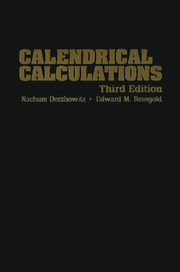Book contents
- Frontmatter
- Dedication
- Contents
- List of Frontispieces
- List of Figures
- List of Tables
- Abbreviations
- Mathematical Notations
- Preface
- Credits
- License and Limited Warranty and Remedy
- About the Cover
- 1 Calendar Basics
- I ARITHMETICAL CALENDARS
- 2 The Gregorian Calendar
- 3 The Julian Calendar
- 4 The Coptic and Ethiopic Calendars
- 5 The ISO Calendar
- 6 The Islamic Calendar
- 7 The Hebrew Calendar
- 8 The Ecclesiastical Calendars
- 9 The Old Hindu Calendars
- 10 The Mayan Calendars
- 11 The Balinese Pawukon Calendar
- 12 Generic Cyclical Calendars
- II ASTRONOMICAL CALENDARS
- III APPENDICES
- Index
- Envoi
- About the Cover
10 - The Mayan Calendars
Published online by Cambridge University Press: 05 February 2014
- Frontmatter
- Dedication
- Contents
- List of Frontispieces
- List of Figures
- List of Tables
- Abbreviations
- Mathematical Notations
- Preface
- Credits
- License and Limited Warranty and Remedy
- About the Cover
- 1 Calendar Basics
- I ARITHMETICAL CALENDARS
- 2 The Gregorian Calendar
- 3 The Julian Calendar
- 4 The Coptic and Ethiopic Calendars
- 5 The ISO Calendar
- 6 The Islamic Calendar
- 7 The Hebrew Calendar
- 8 The Ecclesiastical Calendars
- 9 The Old Hindu Calendars
- 10 The Mayan Calendars
- 11 The Balinese Pawukon Calendar
- 12 Generic Cyclical Calendars
- II ASTRONOMICAL CALENDARS
- III APPENDICES
- Index
- Envoi
- About the Cover
Summary
The invention of the Central American calendar in the Seventh century before Christ may be described with all propriety as one of the outstanding intellectual achievements in the history of man. This calendar solved with conspicuous success the great problem of measuring and defining time which confronts all civilized nations. Moreover it required the elaboration of one of the four or five original systems of writing the parts of speech in graphic symbols, and it conjoined with this supplementary invention of hieroglyphs the earliest discovery of the device of figures with place values in the notation of numbers. This time machine of ancient America was distinctly a scientific construction, the product of critical scrutiny of various natural phenomena by a master mind among the Mayas. It permitted a school of astronomer-priests to keep accurate records of celestial occurrences over a range of many centuries, with the ultimate reduction of the accumulated data through logical inferences to patterns of truth.
—Herbert J. Spinden: The Reduction of Mayan Dates (1924)The Mayans, developers of an ancient Amerindian civilization in Central America, employed three separate, overlapping calendrical systems called by scholars the long count, the haab, and the tzolkin. Their civilization reached its zenith during the period 250–900 C.E., and the Mayans survive to this day in Guatemala and in the Yucatan peninsula of Mexico and Belize; some groups have preserved parts of the calendar systems.
- Type
- Chapter
- Information
- Calendrical Calculations , pp. 137 - 152Publisher: Cambridge University PressPrint publication year: 2007



